This is part 1 of a 3-part series reporting on the 50 speakers delivering 27 different educational presentations at the DirectEmployers (DE) three-day Annual Meeting (DEAMcon23) of DE Members, Recruit Rooster customers, and attendees from the public.
Bios on the presenters are available here. It was the most diverse and inclusive equal employment conference any of the hundreds of attendees had ever attended. And it was exhilarating while simultaneously exhausting. It just wrung you out thinking about all the issues discussed, the solutions offered, and the hopes expressed.
It is exceedingly difficult to condense 27 hours of insightful presentations delivered by some of the most thoughtful speakers in the United States. Here is our best effort to make you feel like you were there with us.
- DirectEmployers’ Executive Director Candee Chambers Welcomed DEAMCon23 Attendees to Chicago for Three Days of Learning, Networking & Amusement
- DE 2022 Accomplishments & Roadmap for 2023
- EEOC Vice Chair Samuels & Commissioner Sonderling Indicated that an EEO-1 Survey Component 2 (“Hours Worked and Pay Data”) Will Soon Return
- John Fox Provided His Patented Candid Scoop on What is Going on at OFCCP
- HR Pros Demonstrated Using DE’s PRM to Manage Outreach
- Veterans’ Employment Support Experts Provided Important Insights on PTSD & TBI
- Recruit Rooster’s Seth Flater Reviewed the Basic Nuts & Bolts of Must Have Recruiting Technologies to Form the Best-Performing and Interlocking Solutions
- Rob Arndt “Climbed A Mountain” to Demonstrate How to Best Leverage the Recruitment and Hiring of Military Veterans
- Using AI-Based Employment Tools the Right Way to Insure Accessibility
- Using the NOD Employment Tracker to Build an Inclusive Workplace
- Shola Richards’ Keynote on “Unstoppable Resilience” Provided 3 Keys to Staying Strong During Any Challenge
DirectEmployers’ Executive Director Candee Chambers Welcomed DEAMCon23 Attendees to Chicago for Three Days of Learning, Networking & Amusement
Unseasonably warm Chicago weather greeted attendees as DEAMCon 2023 began on Wednesday, April 12. Getting the day off to an inspiring start, Ruth Toombs, a Recruit Rooster Sales Manager, led the audience in the singing of the U.S. National Anthem. DE Executive Director Candee Chambers then welcomed the audience, providing an overview of the days to come.
“Each year, we are so grateful to have all of our members, partners, guests, and industry friends who choose to set aside time to attend our annual conference,” Chambers said.
DE 2022 Accomplishments & Roadmap for 2023
Since DEAMcon 2022 in San Diego, DirectEmployers and its family of brands – DE, Recruit Rooster, and RocketBuild – have grown and marked many new accomplishments, including new technology, new partnerships, and multiple awards.
“I’m so incredibly proud of our staff. […] And we do, each and every one of us, try to focus on what we can do better for our Members,” Candee Chambers enthused.
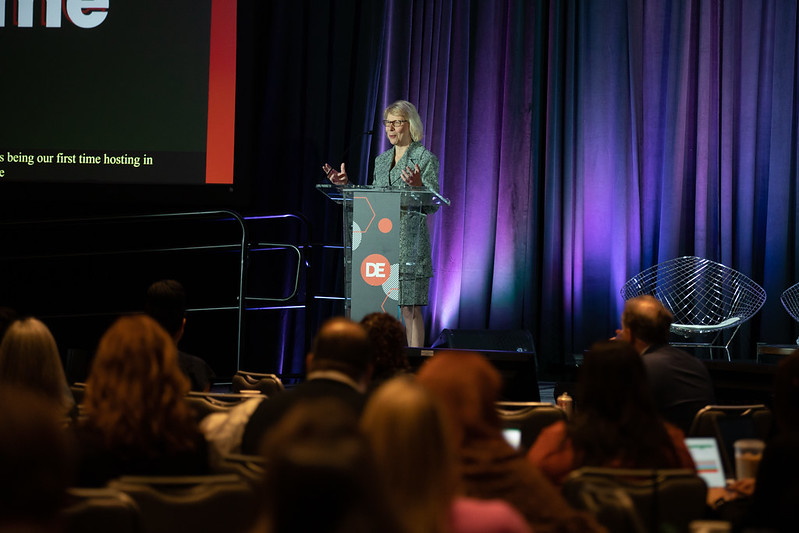 Among other things, Candee noted the OFCCP Week in Review blog had again reached new higher readership levels and was again—for the third year in a row—the number one Blog out of 19,000+ contributors in JD Supra’s Government Contractor space. Candee also pointed out the increasingly more popular weekly short-feature DE Under 3 (minutes) video recaps of the Week In Review’s top story, the DE Talk Podcast series, the relaunch of the National Labor Exchange, and DE’s attendance and presentations at conferences throughout the country. In December, DE also reached a new milestone of 1,000 Members, and is now well on its way to 1100 Members. In addition, Candee highlighted the numerous awards that DE and its family of brands won over the past year. (See DE’s press releases page for more details on these and other accomplishments.)
Among other things, Candee noted the OFCCP Week in Review blog had again reached new higher readership levels and was again—for the third year in a row—the number one Blog out of 19,000+ contributors in JD Supra’s Government Contractor space. Candee also pointed out the increasingly more popular weekly short-feature DE Under 3 (minutes) video recaps of the Week In Review’s top story, the DE Talk Podcast series, the relaunch of the National Labor Exchange, and DE’s attendance and presentations at conferences throughout the country. In December, DE also reached a new milestone of 1,000 Members, and is now well on its way to 1100 Members. In addition, Candee highlighted the numerous awards that DE and its family of brands won over the past year. (See DE’s press releases page for more details on these and other accomplishments.)
Noting DE’s new partnership with OutSolve, Candee welcomed Jeremy Mancheski, OutSolve’s Founder and President, to the stage. “We spend every single day focusing on compliance and excellence for our customers,” Jeremy said. “That’s why this [ ] partnership is so important to [both DirectEmployers and OutSolve.]”
Next up was DE’s Board of Directors President, Chris Liakos. “Each year the DE leadership team and employees exceed our expectations. We pride ourselves […] on defining excellence and unwavering commitments to serving our Members,” he said.
EEOC Vice Chair Samuels & Commissioner Sonderling Indicated that an EEO-1 Survey Component 2 (“Hours Worked and Pay Data”) Will Soon Return
EEOC draft Pregnant Worker’s Fairness Act Regs coming soon, too
We covered this “Fireside Chat” at length in DE’s Week In Review published Monday, April 17, 2022, available here.
John Fox Provided His Patented Candid Scoop on What is Going on at OFCCP
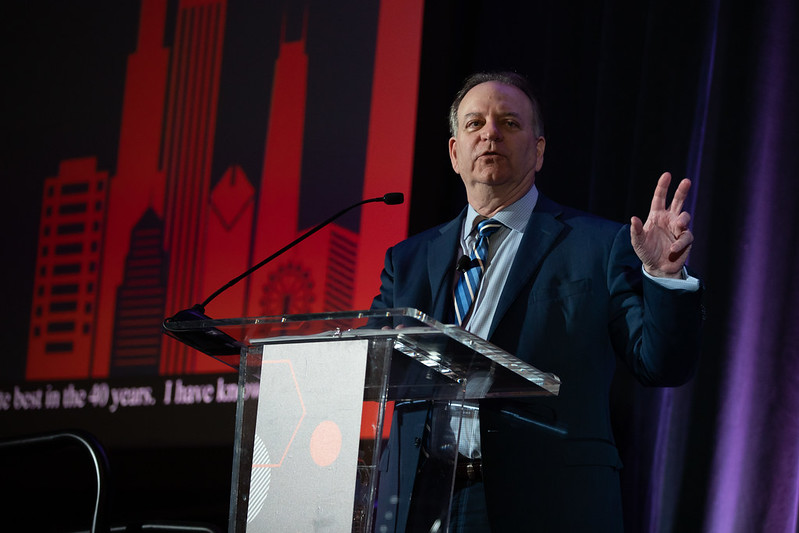
“[T]his once-grand agency [is] failing in front of our very eyes. It is really difficult to observe,” John bemoaned. The OFCCP is down by every metric that any Administration – Republican or Democrat – has ever used in the last 50 years. “Not only is the agency down, but it is down dramatically. Every metric. This is the trend across the board. They’re just in free fall,” he observed.
Personnel Developments
First, John reviewed the agency staffing situation. In March, OFCCP Director Jenny R. Yang and Maya Raghu, a political appointee reporting to Director Yang as the Deputy Director for Policy, both announced their resignations from the agency. As a result, OFCCP may be without a political leader at the top “perhaps long-term until the next presidential election,” he reported. “That is under discussion at the agency right now. If that happens, it will be the first time in the 50-year history of the OFCCP that has occurred.”
Acting Secretary of Labor Julie Su appointed OFCCP Deputy Director Michele Hodge to serve as the agency’s Acting Director until the Secretary of Labor appoints a new political employee to be the agency’s “Director” if she does. However, “nothing is going to change at the OFCCP in terms of audits and policy because [Hodge] has been running it for years,” John pointed out.
While OFCCP always had high turnover, “right now they have to hire four to save three over the course of 12 months,” John noted. “They have had a 25 percent turnover in the first six months of their new hires alone.” Federal contractors are experiencing delays and errors because OFCCP “is now down a third to a half, depending on when you want to count, their [full-time equivalent] positions count,” he explained.
Shift to Centralized Control
John told the audience to “look for increasing centralization [with OFCCP’s organizational structure]” driven by a 2016 U.S. Government Accountability Office (“GAO”) report that said geography is no longer important to enforcement. Specifically, the GAO recommended that “the Secretary of Labor should direct the Director of OFCCP to make changes to the current scheduling list distribution process so that it addresses changes in human capital and does not rely exclusively on geographic location.”
“They’re getting rid of their field structure step by step by step because it is all going into the national office,” John stated. “You will see a lot of the compliance officers from other regions doing your audits because it is all online now,” he added.
Performance Metrics Down Across the Board
John shared a series of slides showing the specific personnel and enforcement numbers to illustrate the gamut of declines. Audits are at an all-time low even as OFCCP is promising audits will slow down even further. Moreover, the agency’s budget continued to decline. “You have heard me say for the last 15 years that I think that they need not just a little more budget but a lot more budget because this agency is now too small,” he noted.
Contractor Portals Are Hard
“I’m sure they wish they never started the portal thing because it has gotten them such a black eye. The problem is the budget […. and] portals are hard,” John observed.
He discussed two portals: (1) the OFCCP Contractor Portal (formerly initially titled “The Contractor AAP Certification Portal”) and (2) the Notification of Construction Contact Award Portal (NCAP). Both portals are unlawful, John pointed out. “That’s why 44 percent of employers last year did not participate in the [OFCCP Contractor] portal because [OFCCP failed to] send it through the [legally required] Administrative Procedure Act [notice and comment procedures].
As to the OFCCP Contractor Portal, OFCCP has “talked about it being a portal to receive all of your documents and audits. They’re not ready to do that yet,” John stated. “They can’t extract the data out of it reliably. So, all of your AAP certifications are largely a mystery to them as we sit today.”
In a related example, OFCCP erred by including companies improperly on its latest Corporate Scheduling Announcement List (“CSAL”). That January 20, 2023, CSAL announced upcoming audits of contractors that OFCCP determined had NOT “certified” their AAPs in the OFCCP Contractor Portal” in 2022 before the often-revised filing deadline eventually became set in concrete for December 1, 2022. However, apparently, about 20 percent of that January CSAL contained the names of companies that had in fact timely certified in OFCCP’s Contractor Portal. “So OFCCP did the right thing and said if we improperly listed you, let us know and we will take your name off the audit list,” John reported. “If you’re one of those, there is still time to do that because they didn’t follow their own rules. And they want to correct that,” he added.
Data extraction problems plague OFCCP in other areas as well, including the OFCCP Submitter Notice Response Portal, John said. [Recent updates on that situation are available here and here; see also John’s discussion of these issues here].
HR Pros Demonstrated Using DE’s PRM to Manage Outreach
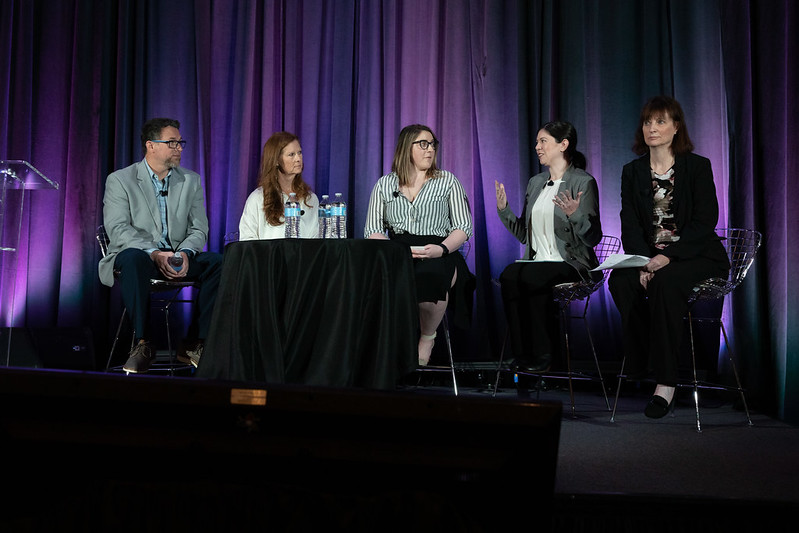
Denise and Heather discussed several examples of how they worked together with Kate, AJ, and Sherry to use the various functions of the PRM to (1) search a directory of diversity and veteran partners by keyword, location, or tag; (2) connect with partners using two-way messaging; document interactions and communication with partners; (3) conduct partnership assessments; and (5) generate outreach reports. “I love that communication report – that’s what I use pretty regularly, at least quarterly,” Heather enthused.
Both Heather and Denise raved about how the PRM provides access to the DE Vetted Partner Library. Heather described this library as “the best in the world.”
While the PRM can automate job delivery to partner contacts, AJ cautioned that just sending a list of your jobs without any other communication with the partner is not an effective approach.
Veterans’ Employment Support Experts Provided Important Insights on PTSD & TBI
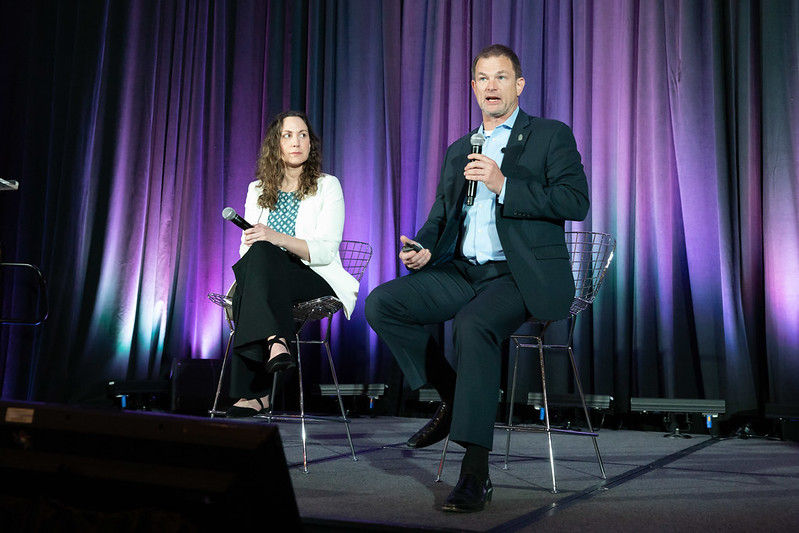
David gave an overview of the profile of what a military candidate looks like, including what roles they have when they are in the military and where they might map to a civilian workforce based on their rank and civilian level. Stephanie then “demystified” common misconceptions about PTSD, TBI, and the veteran workforce.
“PTSD symptoms are a normal reaction to trauma,” Stephanie explained, adding that “PTSD occurs when recovery from trauma is impeded.” Yet, “[m]ost people who experience trauma do not experience PTSD,” she said. PTSD symptoms include disturbing memories, sleep disturbance, avoidance, and increased startle reaction. Although more than half of Americans believe that the majority of U.S. veterans experience PTSD, the truth is that “at max, 20 percent of veterans experience PTSD,” she clarified. Nevertheless, “it is a prevalent and important issue in the veteran community,” she noted. Other prominent misconceptions are that the majority of people with PTSD are violent or dangerous and that PTSD is not treatable. Neither of these beliefs is true, she said.
Common TBI symptoms result from executive functioning issues and can include reduced concentration, headaches, memory problems, and irritability, Stephanie stated.
Both Stephanie and David suggested some specific accommodations and resources, such as: allowing time for medical appointments, desk positioning, noise-canceling headphones, written instructions, closed caption recording on Zoom calls, modifying workplace lighting, and a voice-to-text option for typing. Still, “[e]verything is an experiment. I call everything a pilot. Let’s pilot it and see if it works on both sides and go from there,” Stephanie said. A committed executive level “champion” for supporting veterans (and other employees) with these conditions is also vital, David and Stephanie both emphasized.
Recruit Rooster’s Seth Flater Reviewed the Basic Nuts & Bolts of Must Have Recruiting Technologies to Form the Best-Performing and Interlocking Solutions
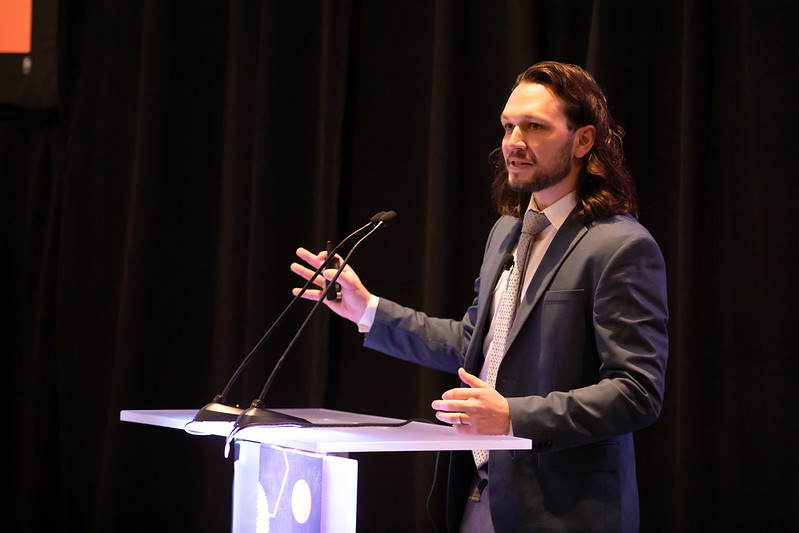
Seth noted that this was quite a change from 2012 when 89% of apply clicks were from desktops. The practice tip takeaway was that corporate career sites need to build for the mobile market. Seth shared many technical “tips and tricks” about ways Recruit Rooster customizes corporate microsites to adapt to the smaller size of cell phones to make them effective recruitment platforms and to increase corporate brand visibility.
Seth also discussed tactics corporates career sites need to adopt to effectively attract veterans to apply, including:
- to mention recruiting veterans on the corporate website (Seth mentioned one customer for which he dramatically increased veterans’ traffic from almost nil by simply including on every website page both a Search Box and a legend that the company had a veterans’ page). “If you land on the job description, it’s there. If you land on the homepage, it’s there. They now get a lot more traffic to their veterans’ page purely because they’re putting more eyeballs on it,” Seth reported triumphantly!
- make your veterans’ page visible on your career website (when responding to customers interested in increasing their veterans’ traffic, Seth reports he often discovers that the veteran’s page is difficult to find).
- make a veterans’ crosswalk available. Seth reported that the Recruit Rooster “Military Skills Translator Crosswalk” will read a veteran’s Military Occupation Code and align those jobs to O*Net Codes (which are standardized and occupation-specific descriptors.) “It reads your positions. You don’t have to do anything,” Seth enthusiastically exclaimed!
- give the veteran a “keyword” and a “location box.” “Half the value of the box is you’re showing you value them enough to try to translate what they did in the military,” Seth suggested.
- Seth also advised that he and his colleagues at Recruit Rooster find great value in giving veterans “an experience” on a customer career site. “So, the premise of this is the DirectEmployers Partnerships Group did a search for free veteran resources which we then vetted,” Seth explained. You are communicating that you value what the veteran did by giving them resources even if there is no currently available job fit. “Here’s free veterans’ resource because you want to leave them with that good taste in their mouth,” Seth explained. He also reported that a popular customer option was to also offer the veteran the opportunity to leave his/her contact information for the company.
Seth used that last thought to segue to Recruit Rooster’s new Talent Community Tool (to be described more fully in our Second Special Edition covering the launch of that tool). Seth explained that the new Recruit Rooster Talent Community software tool captures “passive interests” and builds a contact list for the corporate employer. Seth reported that shockingly, approximately 75% of visitors to career websites nationwide (depending on the industry) do not apply. Recognizing that, Recruit Rooster built its Talent Community tool to lower the burden to potential applicants to get on a corporate TA mailing list to receive job alerts and allow the company to make contact with the prospective candidate. “The concept is just meet them where they’re at and capture the people that you want,” said Seth.
One of Seth’s favorite recruitment tools used to work alongside the Talent Community is available job alerts delivered via e-mail to people who have to leave only their name and e-mail address with a career website. There is much concern in the recruitment industry that job seekers are put off by burdensome registration documents and corporate requests for detailed information.
Seth related this powerful example of a client’s transformation of passive candidate interest to active interest application using the Recruit Rooster recruitment tools in tandem:
“We recently implemented the Talent Community for a commercial airline common carrier. In six months, the airline had 60 open jobs. But it had 20,000 people sign-ups for job alerts”, Seth explained. “They’ve captured them. They’re sort of Trojan horsing,” Seth noted with a smile. “They’ve captured jobseekers just by sending out job alerts and they don’t have to send a newsletter,” Seth exulted.
Then, in tandem with the Recruit Rooster Talent Community software tool, the airline sent out e-mails to those individuals who had signed up for job alerts. “The Talent Community e-mails are already a top ten driver of traffic to their career site,” Seth reported. He further observed that he knew this would occur by converting passive candidate interest to active interest and application to the airline. A success story quickly built from scratch combining Recruit Roosters job alert and Talent Community software tools.
Rob Arndt “Climbed A Mountain” to Demonstrate How to Best Leverage the Recruitment and Hiring of Military Veterans

Rob expanded on each element of “MT. BEN” as follows:
The Mission is to understand the business case for recruiting and retaining military experienced talent. Patriotism and charity, while “beautiful things” cannot be the driving factors. “Your mission has to be establishing what types of roles, what types of segments, do veterans fit in within your organization and be realistic,” he advised.
Building a solid Team to support the Mission requires employing, educating, and empowering internal and external stakeholders throughout various levels and sectors of the business. Military talent initiatives cannot simply be left to those in talent acquisition or recruitment roles, he cautioned.
Distinct from its business brand, a company’s employer Brand is how workers actually view the company. “There are a ton of companies out there that are military friendly. But being military effective takes hard work and dedication,” he stated. Moreover, it’s vital for an employer to be authentic, Rob underscored. “Don’t use stock imagery. The best place to look for photography is your own people,” he said.
Employers also need to view their organization through the eyes of their military-experienced candidates & employees. Viewing this Experience for veteran talent involves not only recruiting but also engaging and retaining that talent.
Finally, employers should analyze and refine their Numbers. They should review their initial mission and evaluate overall progress. “There is a lot of that flag-waving stuff going on and military friendliness. [However,] It doesn’t necessarily move the needle. There has to be accountability with all of the stakeholders,” he said.
Using AI-Based Employment Tools the Right Way to Insure Accessibility
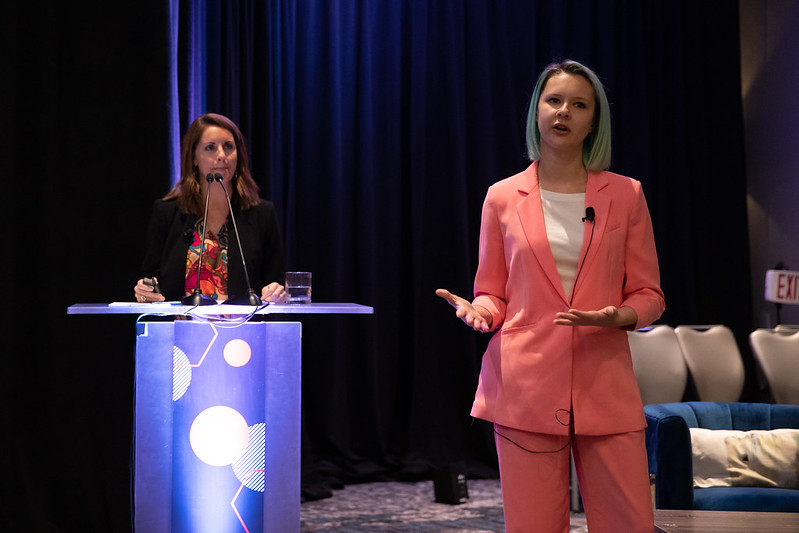
Lex and Sarah provided very practical Practice Tips for companies buying or reviewing their current recruitment and selection technology tools. They both noted the ways Artificial Intelligence can operate to unfairly stop a candidate for employment from proceeding further in the process and also how it could assist employers in their recruitment and selection processes.
- PEAT makes available to the public a free electronic tool known as PEATWorks designed to help employers and the technology industry adopt and promote accessible technology as part of everyday business practices, for the benefit of all employers and workers. PEAT’s website describes the tool as “a central hub for accessible technology-related tools and resources, including the latest PEAT research on the accessibility of online job applications and other eRecruiting technologies.” Lex described PEATWorks as “a guide for anything your procurement team might be looking at to make sure it’s inclusive.”
- When buying, licensing and/or relying upon AI technology in the employment setting, Lex and Sarah offered these tips:
- “One of the important things before you buy AI technology is asking if they can explain it. Is there an explainable AI statement? They’ve made it, of course they should be able to explain it.”
- “Can they explain any bias mitigation steps they’ve taken, specifically disability bias?”
- “Can they clarify the datasets that are used, and how do they judge if they’re effective and fair?”
- “Are humans in the loop,” on the AI development team?
- “Did the vendor use diverse teams with varying lived experiences and characteristics to design and test the platform? And is there evidence or documentation of this?”
- “Are employers utilizing the technology directly involving people with disabilities and defining and assisting with adoption and the roll-out? So is there active involvement in the roll-out of this? If so, then you’ll be able to continuously find and uncover areas for remediation, making it a much more iterative process.”
- “Are employers making sure that humans are continuously involved in auditing AI processes as they evolve during adoption, and how are you logging and handling the adverse incidents? Keeping humans involved in the auditing process can be sure we don’t perpetuate issues that may arise, and then logging these adverse incidents, it’s important to ensure the same mistakes are fully remediated and aren’t made in the future as you bring on new hires or new employees into your team.”
- “Does the platform support applicant disability status self-disclosure while also respecting individual privacy? Not everyone is comfortable disclosing their disability. So always having the option to not disclose personal information is key. But it’s also key to create this trusting environment for those that do decide that they want to disclose.”
- “Does the platform allow applicants to request accommodations during the hiring process, including after they understand how AI is being used in the hiring process? We feel strongly at Inclusively about moving accommodations from the legal and compliance model to more of a social model, and that people can request and are even invited and preempted to request accommodations at any given time and not just as they’re about to go interview or as they’re about to accept the job. Internally in our company we ask people on a quarterly basis, have your accommodations changed? How can we make your job more accommodating for you?”
- “Can applicants provide feedback to and seek assistance from the employer if they encounter a problem? We find this to be a problem with a lot of our clients, we talked about this a little bit with applicant tracking systems. It’s frustrating to not be able to seek assistance and get the answers to the questions that you need. So you need to think about how you incorporate humans into that process to avoid those types of frustrations.”
- “How do you ensure your candidates with disabilities are fully supported? And I’d (Lex) like to kick this off with a request that I would love more time. As I’ve explained, I use a screen reader. Takes a little more time on the front end. Makes me a lot faster in the back end. If you’re in a time box interview situation, like a testing, I’m not going to be able to finish it in that hour, but you will get a great result. So making sure there’s a little bit more time would be really helpful to me.”
- “Does the (online) technology have a statement of conformance to the accessibility standards known as the “Accessibility Performance Report?” WCAG is a set of guidelines created by the World Wide Web Consortium. It’s to make web content more accessible to people with disabilities. The guidelines cover a wide range of topics, including text alternatives for non-text content, keyboard accessibility, color contrast, and more. And then has the technology been tested for compatibility with commonly used assistive technologies and for usability with a variety of users with diverse abilities?”
Talking ATSs?
A member of the audience started this colloquy about making more accessible those ATSs (Applicant Tracking Systems) which interface directly online with job candidates: “What I’ve been thinking about is candidates that have trouble with ATS systems. And we’ve come up with a kind of concierge model. So, if someone has difficulty, there’s a person they can call, a human they can call, and we can help them apply on their behalf. They can contact us by phone, they can contact us via email. I did recently work with a candidate who was having trouble who did not like having that level of human intervention between themselves and the ATS. And I’m wondering, are there ATS systems that will accept applications via voice? Via some other way than typing? Because we don’t know that there’s anything better than having a person help.
Lex responded by saying: “First, thank you for using multi-modal options. That gives them a different way to input, and I appreciate that. You’ve hit on something we’re going to talk about soon which is the chatbot that is voice activated. It’s entirely AI but it is voice activated. I will go through all of their skills and then pop up with job recommendations that match their skills. But I don’t know if it will go through the full application process. We’re getting there. Progress over perfection.”
Using the NOD Employment Tracker to Build an Inclusive Workplace
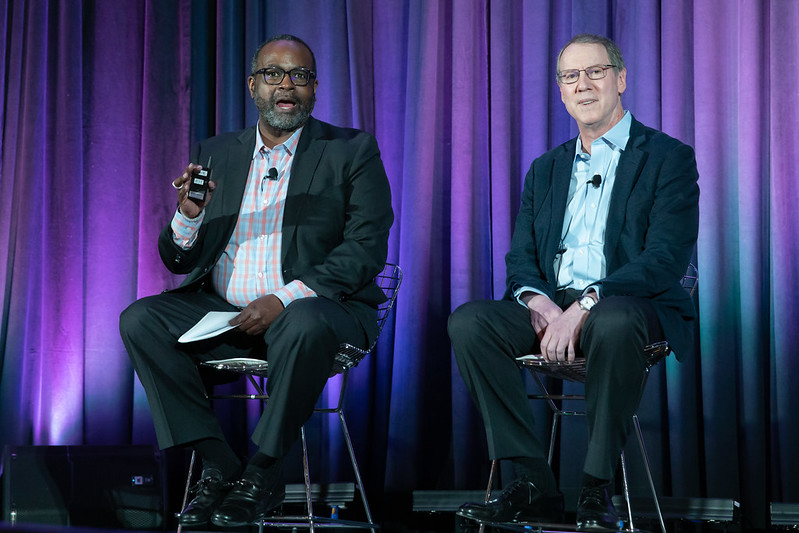
“It has approximately 100 items where we’re asking questions about strategy, culture and climate, workplace practices, and accessibility, as well as people practices and talent outcome metrics. It takes approximately two hours to complete, Chris elaborated. Talent outcome analysis metrics include self-id rate; job applicants, new hires, promotion, retention, high potential employees, and management roles with disabilities. Moreover, the 2023 NOD Employment Tracker survey has been updated and enhanced to dig deeper into leadership commitment, mental health, and accessibility practices.
Stephen Lewis, General Manager of Diversity & Inclusion at Toyota North America (“Toyota”), joined Chris to talk about how Toyota used the NOD Employment Tracker to drive its inclusion strategy. When Toyota first participated in the tracker six years ago in 2017, it was “the kick in the pants we needed actually to get better” Stephen acknowledged. “I would recommend everybody take the tracker […] because if you want to really get a picture of where you stand and where you need to go, that’s the way to do it,” he said.
One example Stephen discussed was problems with self-ID. Their HRIS had previously required applicants to “go into layer after layer after layer in the HRIS to identify.” They recently remedied this issue by fixing their system so they can send out a mass email with a link that takes job seekers directly to a landing page, with a simpler, 5-minute process. In addition, employers should “make it really clear any time we talk about self ID {…] that the information is confidential. Your boss will never see it. The head of HR will never see it. There may be one or two people in data analytics that are sworn to secrecy in all kinds of ways that will crunch the data. But we have to reinforce that,” he advised.
Shola Richards’ Keynote on “Unstoppable Resilience” Provided 3 Keys to Staying Strong During Any Challenge
“Resilience is the ability to withstand, or recover quickly from, difficult circumstances,” explained Shola Richards at the outset of his energetic keynote address. Shola is the CEO and Founder of Go Together Global™, a best-selling author and self-professed “kindness extremist.”
“Seventy percent of the global workforce say this has been the most stressful 12 months of their life, and 70 percent say their mental health has been affected,” Shola observed. Even if you are not in the 70 percent that is struggling, it’s important to “understand that we may be in the same storm, but we’re not in the same boat,” he told the audience. Shola shared the following three practical keys to resilience.
- Key One: Control the Controllables. “[F]ocusing on what you have no power to control” is the recipe for misery. Shola said. There are only three things we can control, according to Shola. They are our actions, our efforts, and our attitude.
- Key Two: Enter the Storm. “[Resilient people] do not run from their problems. They turn to do things that are super hard and uncomfortable,” Shola pointed out.
- Key Three: Build Your Crew. “The easiest way to build your crew is to create environments of psychological safety,” Shola advised. Psychological safety is a belief that one will not be punished or humiliated for speaking up with ideas, questions, concerns, or mistakes.” When you see behaviors you don’t understand remember that “[a]ll bad behavior is an unskilled expression of an unmet need,” he said. Eight things that everyone should have in the crew/network are connections that provide: empathy, humor, purpose, perspective, vision, pushback, help with navigating interpersonal politics, and help and support during “work surges,” when work gets really hard.
Access the Slide Decks from DEAMcon23
Need more than the Cliff’s Notes from DEAMcon23? Download the slide decks from each session, so you can add notes, and gain access to contact information for each of this year’s presenters.
THIS COLUMN IS MEANT TO ASSIST IN A GENERAL UNDERSTANDING OF THE CURRENT LAW AND PRACTICE RELATING TO OFCCP. IT IS NOT TO BE REGARDED AS LEGAL ADVICE. COMPANIES OR INDIVIDUALS WITH PARTICULAR QUESTIONS SHOULD SEEK ADVICE OF COUNSEL.
SUBSCRIBE.
Compliance Alerts
Compliance Tips
Week In Review (WIR)
Subscribe to receive alerts, news and updates on all things related to OFCCP compliance as it applies to federal contractors.
OFCCP Compliance Text Alerts
Get OFCCP compliance alerts on your cell phone. Text the word compliance to 55678 and confirm your subscription. Provider message and data rates may apply.

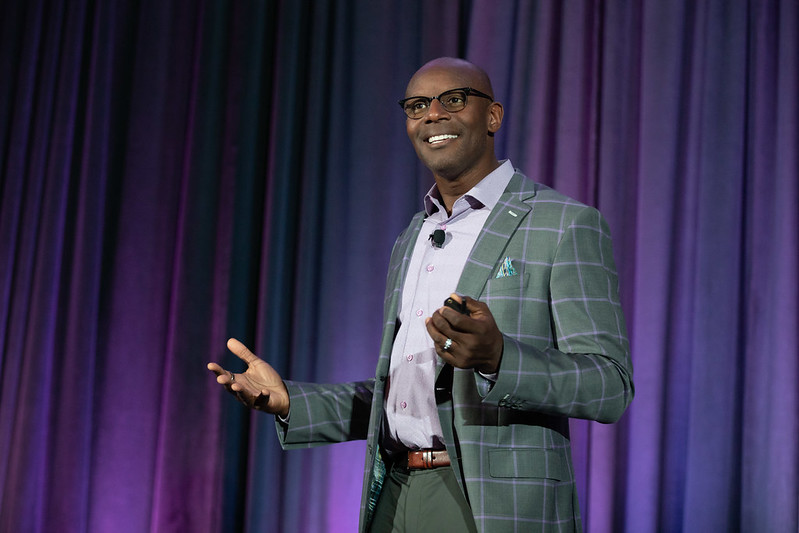 “Resilience is the ability to withstand, or recover quickly from, difficult circumstances,” explained Shola Richards at the outset of his energetic keynote address. Shola is the CEO and Founder of
“Resilience is the ability to withstand, or recover quickly from, difficult circumstances,” explained Shola Richards at the outset of his energetic keynote address. Shola is the CEO and Founder of 